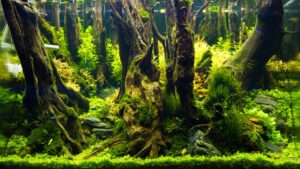The Ultimate Beginners Guide: Basic Fish Keeping

Aquarium Basics
Starting an aquarium is much easier than you might imagine. In fact, here at Aquaclub, we’ve helped thousands of newcomers get started the right way and stay on the right track. Like any subject, the more you learn about it, the more delight you’ll derive. So let us dive into some of the aquarium basics you will need to know to get started.
AQUARIUM
Bigger is better!
It may surprise many to know that larger aquariums are much easier to care for than smaller ones. The reason is simple, the more water you have, the easier it is to keep “balance” in your tank. We always recommend starting with a tank of at least 75 liters or more.
Starter Guide to Aquarium Maintenance
(write this task sheet down. Do not print it out. Let us save some trees!)
Daily
- Feed once or twice daily and minimal quantities
- The aquarium light has to be on for 4-6 hours; 4 hours is good
- Check water temp; 25-26º C is ideal
- Every 15 days change 25% of the water
Monthly
- Change/clean filter cartridge
- Clean tank
- Clean glass (inside and out)
- Clean the decorations (plants, rocks, etc.)
- Clean gravel, siphon up waste
Please note: Use water only, DO NOT use any detergent or soap.

Tank Placement
This is an essential factor that many ignore. It matters a lot.
Choose a location away from direct sunlight, windows, heating or air vents, and high-traffic areas. Fish do get stressed.
EQUIPMENT
The right tools for the right hobby
Filter:
A good filter is the heart of your tank.
It keeps the water clean and healthy. We recommend the following filters for beginners.
- Sunsun HW-603B (18” Aquarium)
- Sunsun HW 302 (2ft Aquarium)
- Sunsun HW 303 (3ft Aquarium)
- Sunsun HW 304 (4ft Aquarium)
- Sunsun HW 3000 (4ft and above Aquarium)
- Sunsun HW 5000 (5ft and above Aquarium)
Talk to us here if you want more advice as to which filter is best for your tank.
The filer depends on your water capacity.
Air Pump & Stone:
Adds an extra boost of oxygen. Yes, fish breath too. Look for one which produces less turbulence and produces a smooth, quiet stream of air. Unless you want vibratory noise all night long, get a noiseless air pump. There are many different types of airstones available. Choose the one that is both good-looking and efficient. We can help you out here again.
Here are some excellent air pumps:
- Sunsun CT 201
- Sunsun CT 202
- Sunsun CT 402
- Sunsun CT 404
Talk to us here
Heater:
Fish are cold-blooded animals. Which means they cannot produce body heat on their own. They depend on the temperature of the water. There are many types of fish found in nature. Some are found in warm water streams, and some are found in cold-water streams. A heater is essential depending on the type of fish you are keeping and the ambient temperature of where you live. If the ambient temperature of where you live drops below 23°C, then you must think of getting a heater. IF you are getting a heater, look for one that turns On/Off automatically; trust us, it is worth it. The low voltage thermostat maintains water at 25-26°C without any adjustment required. Ensure that you are buying the correct heater for your tank size. A heater too small for your tank will cause underheating. It is vital to ensure your tank is equipped with a hood or top cover to contain the heat inside the aquarium.
Here are our top picks:
- Sunsun Heaters
- RS Electrical heaters
- Oase heaters
Talk to us to know more about what size heater to get for your tank.

Lights:
Lights are maybe the single most crucial feature apart from the filter. It is indispensable to provide a good spectrum of light mimicking the natural sunlight. There are various lighting fixtures you can use. It’ll depend on the result you are looking for and the size of your tank. Do keep in mind that underwater plants require light too for photosynthesis.
On average, you should leave the light on for 4-6 hours; 6hours is ideal.
Selecting the correct light is tricky; hence talk to us once before you buy a light.
Gravel/Sand/Substrate:
Besides adding natural beauty, gravel, you can use sand too, which gives beneficial bacteria a place to live. These bacteria help break down the wastes your fish create into good food for your plants.
Water
Clean, full of oxygen, and healthy.
Conditioner: If you are using tap water(like many of us), please remember that there is always a ton of Chlorine in it. This Chlorine will kill your beneficial bacteria. So remember to always add a conditioner when adding tap water to your aquarium to de-chlorinate it. This is important if you want to keep your tank to be at its prime.
The Nitrogen Cycle: The nitrogen cycle is vital for any fish keeper to understand. We will soon share an article on what it is and how to achieve it.
For now, “Cycling” a fish tank means growing healthy bacteria in the new filtration system, so it filters out dangerous toxins. There are solutions available to cycle your tank right away, and you can talk to us to know more
Fish
Start with the easy ones, then learn your way up. Here’s why.
If you are setting up an aquarium for the first time, ensure your tank is cycled correctly, and all the equipment is working fine. That is why we recommend starting with one inexpensive “test” fish.
Here are some best beginner fish you can start with:
- Neons
- Rummy Nose
- Cardinals
- Neon Rainbows
- Hockey Stick
Just like humans, fish needs company, too, and just like humans, fish are picky when it comes to their mates. Fish have personalities. Yes, that is right. Some fish are gentle, calm, and friendly; some try to attack their own reflection. Fish meant for a community are generally good tank mates. In contrast, Aggressive Fish need particular tank mates or none at all. It’s always good to talk to your local retailer or a trusted fishkeeping friend about the best mix of fish.
Do note: Tropical fish and goldfish should not mix.
Accessories
Designing a stunning aquarium is one of the most delightful aspects of having an aquarium. Here are a few tips to get you started.
Use a mix of small, medium, and large plants. More on plant selection and placement in the following posts.
Create a pivotal focal point using a single item. It can be some interesting piece of wood or rock.
Fish like to rest too. Some hiding places should work fine for this. Decorative caves, tunnels, and plants give the fish plenty of a place to hide and make them feel safe.
Artificial plants that look real are straightforward to maintain; however, natural plants help keep the balance in the aquarium. The idea is to recreate nature as much as we can.
Hope you learned something new, and as usual, do wait for our next one.
Till then, happy aquascaping.
